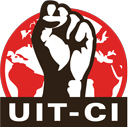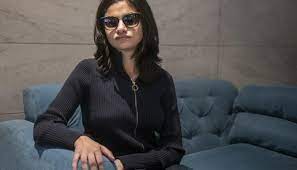by IWU-FI 4 June 2021
Here is an interview conducted by our comrades from Internationalist Fight, Spanish State with Budour Hassan, Palestinian feminist activist, from Jerusalem, who explains to us the April uprising against the Zionist occupier, and develops the idea of intersectionality in the struggle against the Israeli occupation and for the liberation of women. A graduate in International Law from the Hebrew University, she is part of the Tal’at movement [We are coming out].
How do you see the current situation in Palestine, and could the uprising of the last few weeks lead to the outbreak of a Third Intifada?
The most important thing is not to put a name and a surname on what is happening, but to emphasise that we are living a historic moment: a historic uprising. In April, on the first day of Ramadan, clashes broke out between young people and the occupying forces that had blocked the Damascus Gate in Jerusalem. The youth could lift those barriers. And then there was the response to the eviction of families from the East Jerusalem neighbourhood of Sheikh Jarrah. There was a new spirit on the streets, contagious energy that we must take advantage of: something huge and very different from what we have seen so far is beginning. Every night we see demonstrations with women and men protesting. Despite Israel’s massive repression, with all its instruments: the skunk [a pestilent liquid with which they spray the demonstrators, the smell of which lingers for days], the tear gas and the bullets. Then came the day when Israel celebrates its occupation of Jerusalem and Palestinian youth could prevent the settlers from marching with their flags in the Old City, where every year they go to shout “death to the Arabs”. It was a slight moment in the history of our struggle, but it was a moment of liberation: we had the feeling that we can do something, that we can take back the streets of our cities, that the public space is ours. We have also seen demonstrations in al-Ludd and the other cities of historic Palestine. Now the struggle is on both sides of the border: on both fronts. We also saw it on 18 May with the General Strike: all Palestinians took part, everywhere, in Haifa, in Nazareth, in the West Bank, in Jerusalem.
What has changed?
Palestinians have proved that the West Bank and Gaza are not separate reality. That we are one people, a united people despite all Israel’s attempts to divide us. That there are no Arabs who are citizens of Israel and Palestinians who are occupied. In Ludd, there have been huge demonstrations with children painting the Palestinian flag, who are very clear about their Palestinian identity. This unity has given us hope we can start something new with this contagious and revolutionary energy.
How do you explain the entry on the scene of the Palestinians of 1948, those who have second-class Israeli citizenship?
It is not the first time that Palestinians in Haifa, in Nazareth, in all the neighbourhoods, villages and towns of historic Palestine have taken part in the struggle. There are many historical examples. All Palestinians suffer from the occupation: the expropriation of land, the repression, the attempt to erase their identity in the history books. We are talking about the same regime, colonialism of oppression, racism, even if it has unfamiliar faces and manifestations. Its aim everywhere is the same: to eliminate the resistance of the Palestinian people, to eradicate our identity, and to occupy our lands. Israel threatens every facet of our lives. Nor did the Palestinians of 1948 may build, to control their land, to a decent education, to live in peace. Inside Israel, the police are part of the system of organised violence. And poverty is also a consequence of this institutional racism. They said that the youth of historical Palestine had lost their identity, but this has been proven not to be true.
Israel knows only too well the importance of what has happened, especially in the 1948 lands, and wants to put an end to it at any cost. That is why there is a campaign of mass arrests against the Palestinians living in Israel. We can achieve a politicisation of this generation, a new consciousness because the same methods of oppression are being used there as in the West Bank or Jerusalem: houses are being invaded to arrest the youth. There is a new sense of belonging.
Tell us about the role of women in the current situation
Palestinian women have always been very active in the struggle. Since the Arab revolution of 1936, they have been involved in the struggle for freedom and decolonisation. Until the First Intifada, women played a very important role in the leadership and organisation of the popular movements, in the strikes and also in popular education. This role of women had been limited during the 1990s and the Second Intifada, because we are talking about a more religious, more Islamist society, after the creation of Hamas and the other religious movements. But in the current situation, the role of women is striking, on the streets, in the organisation, everywhere: from the front line of the demonstrations to the lawyers who defend the detainees or those who photograph the repression and document human rights violations. Also, in the movement’s organisation: in the coordination of the mobilisations, writing the leaflets or the posters or the songs that are played in the streets. The abuses and arrests of women by Israeli forces are meant to intimidate us.
Can you tell us what Tal’at is and how it came into being?
It is a Palestinian women’s movement that means “We are coming out”, whose aim is to denounce the occupation and patriarchy: Palestine cannot be free if its women are not free. It arose after the murder of Israa Grhayeb, a woman from Bethlehem. She was killed for having a relationship against the will of the family. It was an honour killing. We fight against colonialism, against occupation and also against patriarchy. Through public action, we can see the intersectionality between the feminist struggle, the struggle against patriarchy and also the struggle against colonialism. Understanding how systems of oppression are interwoven is important to understand their origins and how we can resist. It is a historical accumulation of the struggle of several generations. Our struggle against occupation and for social change is even more difficult. Because to change what is happening in your society, in your community, start from zero. To change the mentality of our brothers, our parents, our friends. And this change is hard, but we see some light at the end of the tunnel. There are also moments of helplessness. There is a new generation of girls and hopefully also of boys who want to change things. Because we realise social change is not only for women: it is for the whole of society.
I believe that with our participation in the street, in the public space, in our confrontation with traditions, we can also contribute to repressing oppressive values against men, boys, young people, those who are different. This is the intersectionality of our struggles, the connection between the national struggle and the feminist struggle against patriarchy.
What is the dialectic between occupation and patriarchy?
We build on the work of feminist thinkers like Angela Davis or Silvia Federici, who developed the connection between the class struggle, against colonialism, against international racism and the women’s struggle. And it is not only the theory of intersectionality but what we can see on the streets. When Israeli police attack or sexually abuse a protester, or when she goes to her parents to tell them what she has done, we see a conservative society pressuring women not to join in protests. These are manifestations of the connection between the occupation system and the patriarchal system.
We also see it in the laws on family reunification or land ownership or in the policy’s impact of house demolitions on the poorest women. Patriarchy and occupation are connected systems. There will be no free Palestine without the liberation of its women. Without a radical change in our ways of thinking and struggle. The liberation struggle is in the streets, in our homes, in our workplaces. These are the places where we must direct our mobilisation.
What do you think of the traditional Palestinian leaderships, Al-Fatah and Hamas?
I don’t support either of these two movements. Many Palestinians see the Palestinian Authority [under Al-Fatah control] as an extension, an agent of the occupation in the West Bank. This has been very clear in recent years, and now too: the Palestinian police and its intelligence forces have arrested many activists under so-called “security coordination”. Since its foundation, the Palestinian Authority has played a very clear role in consolidating the occupation, repressing the Palestinians and assisting the occupation. As for Hamas, it is a patriarchal religious movement. We have to distinguish when we talk about resistance, all Palestinians support it because it is an anti-colonial resistance, against the occupation. But as a party, in Gaza, where they have been ruling since 2007, they have played a repressive role against freedom of expression and women’s freedom. It is a problem when the only military force of resistance is an Islamist force, very anti-feminist, anti-women and anti-freedom













